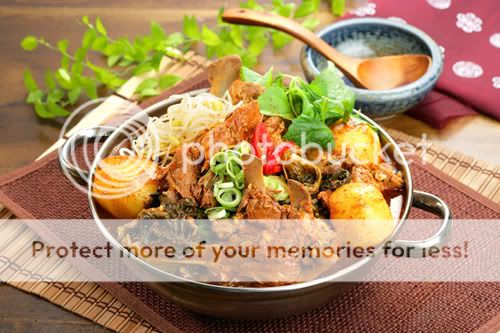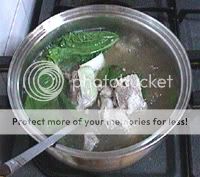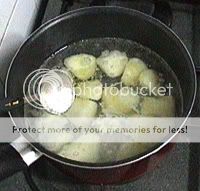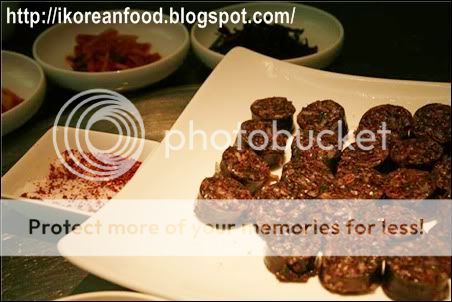12/01/2009
감자탕 Spicy Pork Stew with Potatoes
11/15/2009
김치냉장고 Kimchi Fridge
11/10/2009
오징어 덮밥 Stir-fried Octopus with Rice

11/07/2009
순대볶음 Stir-fried Korean Pork Sausage

The ingredients are as follow:
Soon-dae (Korean Pork Sausage)
Cabbage
Pork Intestine
Carrot
Onion
Grinded Sesame Seed
Vermicelli Noodles
Korean Chilli Sauce
Genip (A greenish vegetable)

When you cook, put all the ingredients in a pan and cook it until it is all mixed. Add the chilli sauce as much as you like. However, the more spicy it is, the more delicious it would be.

Genip, a type of vegetable, is use to put into the dish because it helps in making the smell of the sausage disappear, so the taste will be more mild.
11/02/2009
순대 Korean Pork Sausage
Koreans, especially adults, love to have Soon-Dae with Soju or Korean liquor. And, there's also a seasoning that comes along with it, which is made up of salt, pepper, and chili power to add on some flavor to the sausage. Soon-Dae are usually eaten with side dish such as cubed radish kimchi, kaktugi.
10/16/2009
We're Back!
Anyway, today let's have a look at some mouth-watering pictures ... Thank you google.co.th ^ ^


2/07/2009
Cinnamon and Ginger Tea With Persimmons 수정과

Ingredients
10 cinnamon sticks
5 - 6 pieces of ginger
10 cups of water
2 cups of sugar
1/4 cup of pine nuts
10 dried persimmons (gotgam)

Procedures
Add water, cinnamon sticks, and ginger into a big pot.
Wait for it to boil for about 1 - 2 hours.
Add sugar. (This depends on how sweet you want it to be)
Let cool for a while, then put it in the refrigerator.
Serve with persimmon inside and some pine nuts on top.

2/05/2009
Culture Capsule 10
People don’t speak in the first person in Korea. We don’t often use the pronoun ‘you’ either, especially to someone older than you. While you can use the name of a younger brother/sister or a friend of the same age, you can’t use your colleague’s name, boss’s name or the name of someone you don’t know well. In the family or at school, girls can call an older brother, older male friend ‘오빠’ and boys can use ‘형’. Likewise, girls can call an older sister, older female friend ‘언니’ and boys can use ‘누나’. In the office, it’s a good idea to add ‘님’ to the last name and job title of all older people. Among colleagues, they add ‘씨’ after a man or woman’s full name.
- Write reference Korean Languge Education Center, Sogang University
1/31/2009
Cha-Chang-Myeon 자장면

.
Cha-Chang-Myeon is a kind of noodles, which is very popular in Korea, especially among children. Cha-Chang-Myeon has a mixture of both Korean and Chinese food. You can try tasting the original one at the China Town located in Incheon.
.

.
How to Cook :
.
The Sauce
1. In a pot, put in a small amount of oil, pork, spring onion, ginger, onion or you can also put in some garlics.
2. Stir the ingredients together until they are cooked.
3. Add Joong-Kook-Twen-Jang (Chinese Bean Paste), cooking liquor, soup, and wait for it to boil.
.

.
When serving, you just have to pour the sauce onto the noodles and mix it well.
.

.
1/28/2009
Mandoo guk 만두국(Korean dumpling soup)
Mandoo guk is a food from China.
Ingredients:
20 dumplings, 4 oz beef, 2 green onions
1/8 teaspoon soy sauce, 1/8 teaspoon sesame oil
salt, pepper, 6 cups water, 1 egg, mixed
1 sheet seasoned gim (dried seaweed, nori), crushed
1/26/2009
Culture Capsule 9
Honbok, the Korean traditional dress, has been handed down in the same form unchanged for hundreds of years because it is well suited to the Korean climate and culture. The man's basic outfit consists of a jeogori(jacket), baji(trousers), and durumagi (overcoat).
The jacket has loose sleeves and the trousers are roomy and tied with straps around the ankles. The woman's has includes a jeogri(short jacket) with two long ribbons, which are tied to form the otgorum, and has long full sleeves and a full length, high-waisted wrap around skirt called the chi'ma. White cotton socks and boat-shaped shoes, made of silk, straw, or rubber, are worn with this clothing.


1/24/2009
Stir-Fried Squid 오징어 볶음
1/21/2009
Kimchi Roe Rice 김치알밥
1/19/2009
Culture Capsule 8
Typically, a Korean name consists of a family name and a given name which is typically made up of two Chinese characters. For instance, take a common Korean name such as 'Kim Yeong Su'. Here 'Kim' is the family name and 'Yeong Su'is the given name.
Traditionally, when parents select a child's given name in Koream the given name is derived from two Chinese characters. One Chinese characters is affixed according to generation so that brothers, sisters and cousins would have the same Chinese character. The second Chinese character would be individually selected by the parents. Based upon two Chinese characters, a child would receive his given name. However, many modern Korean parents have chosen a different method in selecting their child's given name. Instead of selecting their child's given name via the use of Chinese characters, many Korean parents have chosen to select pure Korean names without any reference to Chinese characters.
Currently, there are approximately 90 family names in Korea. Some of the most common family names in Korea are Kim, Lee, Park, and Choi. In most western countries, after a woman marries she legally adopts the husband's family name as her own. However in Korea, a woman maintains her family's name throught her life.
-Write reference Korean Languge Education Center, Sogang University
1/17/2009
Kimchi Jim 김치찜
1/16/2009
Soondooboo jjigae 순두부 찌개 (Soft tofu stew)

Ingredients:
1 pack soon doo boo (soft tofu)*
8 small clams - cleaned, 4 ounce pork (or beef) - sliced
1/4 cup kimchi - roughly chopped, 1 red hot chili - sliced
2 green hot chilies - sliced, 2 green onions - sliced
1 egg york, 1 tbsp go choogaroo (Korean chili powder)
1 tbsp vegetable oil, 1 tsp minced garlic, 1/2 tsp juice of ginger
1 tsp soy sauce, 1/2 tsp sesame oil
1 tsp sae woo jeot (salted shrimp)**
3 cups water
(*It is in a tube, different from square package soft tofu in a Korean super market.)
(**Salt can be used.)

How to cook:
Marinade pork with ginger juice, soy sauce, sesame oil and minced garlic.
In a pot, add vegetable oil and saute pork.
Add go choo ga roo (Korean chili powder), keep stir.
Add water and kimchi, bring to a boil.
Scoop in soon doo boo with a spoon.
Reduce heat, add sae woo jeot (salted shrimp).
Add chillies, green onions and clams.
Cook for a minute or so.
Finish with egg york in the center and a dash of sesame oil.
Serve with rice.
1/14/2009
Mul naengmyon 물냉면(Buck wheat noodle in cold beef broth)
Ingredients:
5 oz naengmyon noodle
1/3 pound beef shank
1/4 English cucumber, julienne
1/2 Asian pear, julienne
1 egg, hard-boiled, sliced in half
1/4 cup pickled radish*
sugar, vinegar, gyeoja (Korean mustard)
1/4 inch piece ginger
4-5 cloves of garlic
1 tsp. salt, 1/2 tsp. pepper
(*Pickled radish - Julienne radish.
Add 1 tbsp vinegar, 1 tbsp sugar, 1/4 tsp salt.
Mix well, leave in a refrigerator for at least 30 minutes.)
How to cook:
Put beef, garlic, ginger, salt, and pepper to a boiling water and cook until soft.
Take out the meat and slice very thinly.
Set aside.
Save broth, strain, put in a refrigerator.
Skim fat on top.
In a big pot of boiling water, add noodle.
Cook for 3-5 minutes depends on instruction of the package.
Wash in a cold water for several times to get rid of excess starch.
Drain and set aside.
In a big bowl, pour chilled broth, some ice and add noodle.
On top, garnish with an egg, pear, cucumber and picked radish.
Serve with sugar, vinegar and gyeo ja (Korean mustard).

Tips: "NaengMyon" is one of the most desirable dishes in summer.There are two types of NaengMyon noodles, "PyeongYang" style and "HamHeung" style."Naeng Myon" noodle is made with buck wheat and potato starch, unlike Japanese "Soba" noodle,the chewy texture is a trademark.































